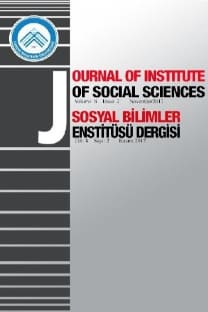Kamu Çalışanlarının Sanal Kaytarma Amaçları Üzerine Ampirik Bir Araştırma
An Empirical Research on the Public Officials’ Objectives of Cyberloafing: A Case of a Public Institution
Objectives of Cyberloafing, Public Officials, Public Institution,
___
- Akca, A. (2013). Okul Yöneticilerinin İş Dışı İnternet Kullanım (Siber Aylaklık) Davranışlarının İncelenmesi, Yüksek Lisans Tezi Yıldız Teknik Üniversitesi Sosyal Bilimler Enstitüsü, İstanbul.
- Altunışık, R., Coşkun, R., Bayraktaroğlu, S., Yıldırım, E. (2010). Sosyal Bilimlerde Araştırma Yöntemleri, Sakarya Yayıncılık, 6. Baskı, Sakarya.
- Anandarajan, M., Simmers, C.A. (2004). Constructive and Dysfunctional Personal Web Usage in the Workplace: Mapping Employee Attitudes. 1-27, içinde Personal Web Usage in the Workplace: A Guide to Effective Human Resources Management (editörler: M. Anandarajan, C. Simmers), Information Science Publishing.
- Anandarajan, M., Devine, P., Simmers, C.A. (2004), A Multidimensional Scaling Approach to Personal Web Usage in the Workplace. 61-79, içinde Personal Web Usage in the Workplace: A Guide to Effective Human Resources Management (editörler M. Anandarajan ve C. Simmers), Information Science Publishing.
- Anandarajan, M., Simmers, C.A., D’Ovidio, R. (2011). Exploring the Underlying Structure of Personal Web Usage in the Workplace. Cyberpsychology, Behavior, And Social Networking, 14(10): 577-583.
- Belanger, F., Slyke, C.V. (2002). Abuse or Learning?. Communications of the ACM, 45(1): 64-65.
- Blanchard, A.L., Henle, C.A. (2008). Correlates of Different Forms of Cyberloafing: The Role of Norms and External Locus of Control. Computers in Human Behavior, 24: 1067-1084.
- Chak, K. (2003). Shyness and Locus of Control as Predictors of Internet Addiction and Internet Use. A Graduation Project in Partial Fulfillment of the Requirement for the Degree of Master of Science in New Media, The Chinese University of Hong Kong.
- Davis, R.A. (2001). A Cognitive-Behavioral Model of Pathological Internet Use. Computers in Human Behavior, 17: 187-195.
- Doorn, O.V.N. (2011). Cyberloafing: A Multi-Dimensional Construct Placed in a Theoretical Framework. Masters Thesis, Eindhoven University of Technology, Department Industrial Engineering and Innovation Sciences.
- Foster, M. (2001), Be Alert to the Signs of Employee Internet Addiction. National Public Accountant. 46, 39-40.
- Garrett, R.K., Danziger, J.N. (2008). Disaffection or Expected Outcomes: Understanding Personal Internet Use During Work. Journal of Computer-Mediated Communication, 13: 937-958.
- Kalaycı, Ş. (2008). SPSS Uygulamalı Çok Değişkenli İstatistik Teknikleri, 3. Baskı, Ankara: Asil Yayın Dağıtım.
- Liberman, B.S., McKenna, G.K., Buffardi, L.E. (2011). Employee Job Attitudes and Organizational Characteristics as Predictors of Cyberloafing. Computers in Human Behavior, 27: 2192-2199.
- Lim, V. (2005). The Moderating Effect of Neutralization Technique on Organizational Justice and Cyberloafing. PACIS 2005 Proceedings, pp: 207-219, http://aisel.aisnet.org/pacis2005/18.
- Lim, V.K.G., Chen, J.Q. (2012). Cyberloafing at the Workplace: Gain or Drain on Work?, Behaviour. Information Technology, 31(4): 343-353.
- Lim, V.K.G., Teo, T.S.H., Loo, G.L. (2002). How do I Loaf Here? Let Me Count the Ways. Communications of the ACM, 45(1): 66-70.
- McLean, L., Tingley, M., Scott, R.N., Richards, J. (2001). Computer Terminal Work and the Benefit of Micro Breaks. Applied Ergonomics, 32: 225-237, aktaran: Doorn, O.V.N. (2011), Cyberloafing: A Multi- Dimensional Construct Placed in a Theoretical Framework, Masters Thesis, Eindhoven University of Technology, Department Industrial Engineering and Innovation Sciences.
- Örücü, E., Yıldız, H. (2014). İşyerinde Kişisel İnternet ve Teknoloji Kullanımı: Sanal Kaytarma. Ege Akademik Bakış, 14(1): 99-114.
- Özkalp, E., Aydın, U., Tekeli, S. (2012). Sapkın Örgütsel Davranışlar ve Çalışma Yaşamında Yeni Bir Olgu: Sanal Kaytarma (Cyberloafing) ve İş İlişkilerine Etkileri. Çimento İşveren Dergisi, 26(2): 18-33.
- Page, D. (2014). Teachers’ Personal Web Use at Work. Behaviour and Information Technology, 1-11.
- Ünal, Ö.F., Tekdemir, S. (2015). Sanal Kaytarma: Bir Kamu Kurumunda Ampirik Bir Araştırma. Süleyman Demirel Üniversitesi İktisadi ve İdari Bilimler Fakültesi Dergisi, 20(2): 95-118.
- Weatherbee, T.G. (2010). Counterproductive Use of Technology at Work: Information and Communications Technologies and Cyberdeviancy. Human Resource Management Review, 20: 35-44.
- Young, K.S. (1996). Internet Addiction: The Emerge of a New Clinical Disorder. Cyberpsychology and Behavior, 1(3): 237-244.
- Young, K.S., Pistner, M., O’Mare, J., Buchanan, J. (1999). Cyber Disorders: The Mental Health Concern for the New Millennium. CyberPsychology & Behaviour, 2(5): 475-479, aktaran: Doorn, O.V.N. (2011). Cyberloafing: A Multi-Dimensional Construct Placed in a Theoretical Framework, Masters Thesis, Eindhoven University of Technology, Department Industrial Engineering and Innovation Sciences.
- Young, K., Pistner, M., O’Mara, J., Buchanan, J. (2000). Cyber-Disorders: The Mental Health Concern for the New Millennium. Cyber Psychology and Behavior, 3(5): 475-479.
- ISSN: 1309-3738
- Yayın Aralığı: 2
- Başlangıç: 2010
- Yayıncı: Prof. Dr. Coşkun POLAT
Bankacılık Sektöründe Çalışanların Beklentilerine Yönelik Bir Araştırma: Isparta İlinde Bir Uygulama
Mehmet Levent ERDAŞ, Ezgi CEVHER
Türkiye’nin Emek Yoğun Mallarda Rekabet Gücünün Ölçümü: BRIC Ülkeleri İle Karşılaştırmalı Analiz
Orta Sınıfa Yönelik Konut Reklamlarının Göstergebilimsel Yöntemle Analizi
Samsun İlinde Kırsal Göç Üzerinde Etkili Olan Faktörler
Sınıf Öğretmenlerinin Fen Bilimleri Konularının İçeriğini Belirlemedeki Kriterleri
Mücahit KÖSE, Nida BAYINDIR, Hüseyin ÇAVDAR
Sağlık Sektöründe İşgören Motivasyonunun İnovasyon Performansına Etkileri
Türkiye’de Göçmen Eğitimi Sorunsalı ve Göçmen Eğitiminde Farklılığın Yönetimi
Mukaddime’ye Giriş: Kahır ve Şiddete Dayalı Siyasetin Yükseliş ve Düşüşü
